Annual Report 2008 - Komax Group
Annual Report 2008 - Komax Group
Annual Report 2008 - Komax Group
You also want an ePaper? Increase the reach of your titles
YUMPU automatically turns print PDFs into web optimized ePapers that Google loves.
Corporate governance<br />
The Remuneration Committee determines the salary<br />
and the bonus of the CEO and the members<br />
of <strong>Group</strong> Management, as well as the compensation<br />
of the Board of Directors. At the beginning of<br />
the year, it establishes goals which must be met<br />
for the bonus to be payable. The committee also<br />
sets the terms for the employee share ownership<br />
programme.<br />
Both committees meet as necessary and meetings<br />
may be called by any member.<br />
Work methods<br />
The Board of Directors has a quorum if an absolute<br />
majority of its members is present in person. Resolutions<br />
are adopted by a majority of votes present.<br />
In the event of a tie, the Chairman casts the deciding<br />
vote. All resolutions are minuted.<br />
The Board of Directors meets as often as business<br />
requires, but no less than three times per<br />
year. Meetings are called by the Chairman of the<br />
Board. Each member of the Board of Directors<br />
may demand that a meeting be called to discuss<br />
a particular topic. In the <strong>2008</strong> financial year, the<br />
Board of Directors met five times, the Audit Committee<br />
twice and the Remuneration Committee<br />
once for regular scheduled meetings. The meetings<br />
of the Board of Directors lasted around six<br />
hours on average, those of the Audit Committee<br />
and Remuneration Committee around three. This<br />
quoted times pertain to the actual duration of the<br />
meetings and do not take into account the extensive<br />
preparatory and follow-up work done by the<br />
individual members.<br />
Definition of areas of responsibility<br />
The Board of Directors has exercised its statutory<br />
power to delegate management in whole or part<br />
to a committee, to individual members (the President<br />
and CEO) or to third parties, who need not be<br />
shareholders (senior management), reserving such<br />
duties as may not be delegated or withdrawn.<br />
Under the provisions of the Organizational Regulations,<br />
the Board of Directors has delegated the<br />
management of ongoing business to the senior<br />
management (<strong>Group</strong> Management) under the<br />
chairmanship of the chief executive officer (CEO).<br />
The CEO is responsible for the overall management<br />
of the <strong>Komax</strong> <strong>Group</strong> and for all matters<br />
not falling under the purview of another governing<br />
body of the company by law, the Articles of<br />
36 | 36 |<br />
<strong>Komax</strong> <strong>Annual</strong> <strong>Report</strong> <strong>2008</strong><br />
Association or the Organizational Regulations. In<br />
particular, the CEO is responsible for operational<br />
management as a whole.<br />
The <strong>Group</strong> Management consists of the chief executive<br />
officer (CEO) and the division heads reporting<br />
directly to him at company headquarters.<br />
Information and control instruments vis-àvis<br />
the senior management<br />
The CEO informs the Board of Directors at each<br />
meeting of the course of business, the <strong>Group</strong>’s<br />
most important transactions and how the tasks<br />
delegated to the senior management are being<br />
fulfilled.<br />
The internal audit team supports the Audit<br />
Committee in assessing the effectiveness of the<br />
company’s risk management framework, internal<br />
control system and management and monitoring<br />
processes. Internal audit duties are performed<br />
by the Finance & Accounting unit of <strong>Komax</strong> AG,<br />
Dierikon. In accordance with the annually prepared<br />
audit plan, this unit carries out regular audits of<br />
all foreign subsidiaries as well as of the individual<br />
departments at the <strong>Group</strong>’s head office and its<br />
Swiss companies and operating facilities. The Audit<br />
Committee reviews and approves the scope of<br />
the audits, the annual audit plan and the responsibilities<br />
of the internal audit team. It also decides<br />
on any measures to be implemented as a result<br />
of internal audit findings. In addition, any audit<br />
findings which could result in a material change<br />
to the financial statements or which reveal material<br />
irregularities of a criminal nature or which are<br />
otherwise significant are immediately reported to<br />
the Board of Directors.<br />
The <strong>Komax</strong> <strong>Group</strong>’s management information system<br />
(MIS) is organized as follows: Each subsidiary’s<br />
key balance sheet and profit and loss figures<br />
are compiled and consolidated once a month. The<br />
subsidiaries’ balance sheets, income statements,<br />
cash flow statements and various indicators are<br />
compiled and consolidated on a quarterly, halfyearly<br />
and yearly basis. As part of this process,<br />
the figures are compared with those of the previous<br />
year and the budget. The budget forecast<br />
is checked for attainability against the quarterly<br />
statements for each individual company and on<br />
a consolidated basis. The financial reports (MIS)<br />
are discussed at meetings of the Board of Directors<br />
with the chief executive officer (CEO) and the<br />
CFO.<br />
The internal control system (ICS) and regular reviews<br />
of this system ensure early identification and<br />
minimization of risks, weak points and gaps in security.<br />
The goal of the ICS is to assure compliant<br />
and efficient business administration, protection of<br />
business assets, prevention or detection of criminal<br />
acts and errors, accuracy and completeness of<br />
accounting records and timely issuance of reliable<br />
financial information. These goals are achieved by<br />
means of systematic methods and measures (key<br />
controls). The defined key controls are reviewed in<br />
a cyclical and methodical procedure based on a<br />
separate schedule prepared annually by the CFO<br />
for this purpose. The audit is carried out by the<br />
Finance & Accounting unit of <strong>Komax</strong> AG, Dierikon.<br />
As part of the audit, the extent to which the ICS<br />
objectives have been achieved is determined and<br />
an ICS annual report is prepared and submitted to<br />
the Audit Committee together with a proposal for<br />
the implementation of measures to address unmet<br />
requirements (action plan).<br />
In addition, the ICS annual report should contain<br />
a proposal on which information on the execution<br />
of the risk assessment carried out in the context<br />
of the ICS should be included in the notes to the<br />
balance sheet.<br />
Extraordinary occurrences and important decisions<br />
as specified in the <strong>Komax</strong> Holding AG Organizational<br />
Regulations are brought to the attention of<br />
all members of the Board of Directors in writing<br />
immediately.<br />
Senior management<br />
Members of senior management<br />
Beat Kälin<br />
Overall management of the <strong>Komax</strong> <strong>Group</strong>, chief<br />
executive officer (CEO), Swiss national. Dipl. Ing.<br />
ETH and Dr. sc. techn. ETH, MBA INSEAD, born<br />
1957, with <strong>Komax</strong> since 2006, in present position<br />
since 11 May 2007. Professional background prior<br />
to joining <strong>Komax</strong>: He spent the major part of his<br />
early career with the Elektrowatt company before<br />
moving into the packaging industry (SIG) and subsequently<br />
becoming a member of the Board of<br />
Bosch Packaging Technology.<br />
Claudio Meisser<br />
Head of Research & Development (CTO), Swiss<br />
national. Dipl. El.-Ing. ETH/SIA, born 1945, with<br />
<strong>Komax</strong> as CTO since 1992. Professional back-


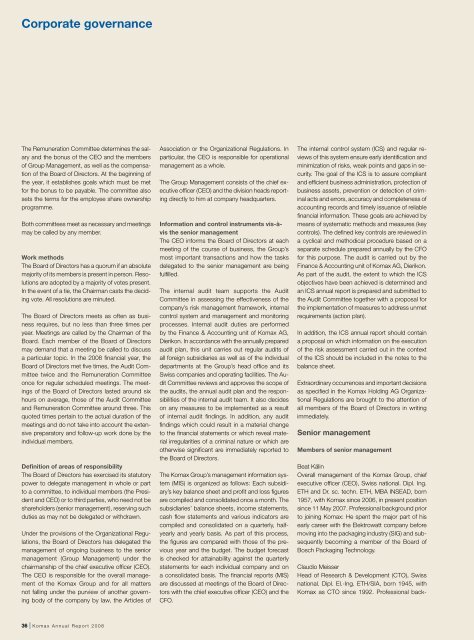
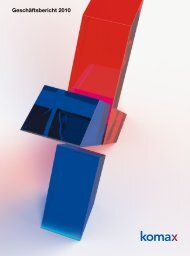

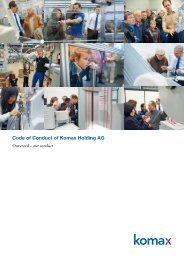
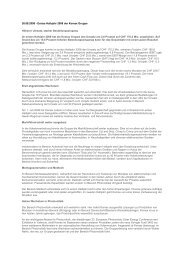
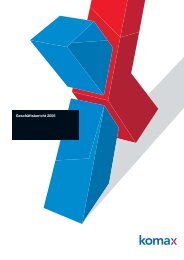

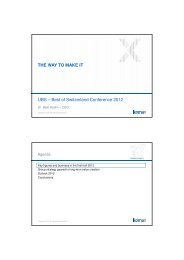

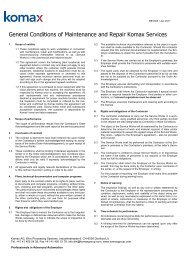



![[PDF] bt 712 - Komax Group](https://img.yumpu.com/9969024/1/184x260/pdf-bt-712-komax-group.jpg?quality=85)
![[PDF] mci 765 C - Komax Group](https://img.yumpu.com/9969021/1/184x260/pdf-mci-765-c-komax-group.jpg?quality=85)